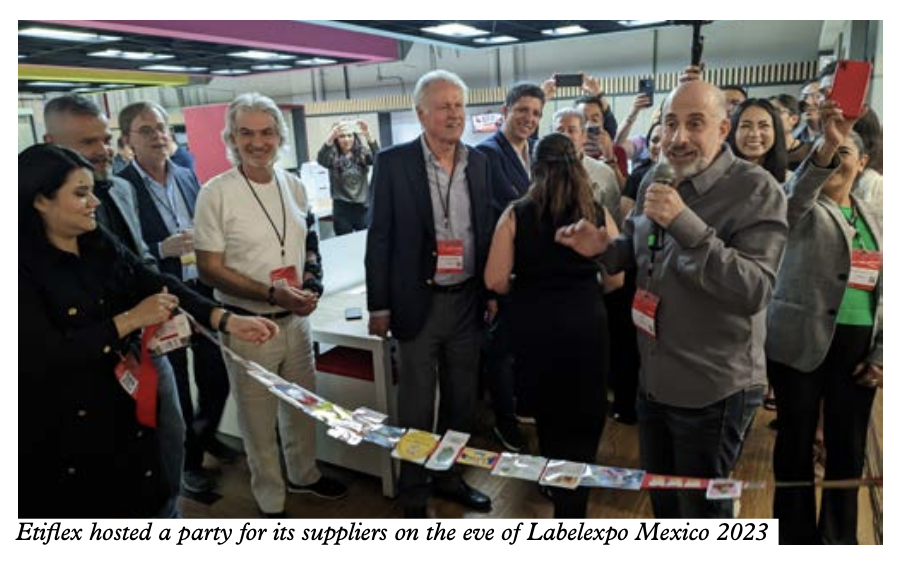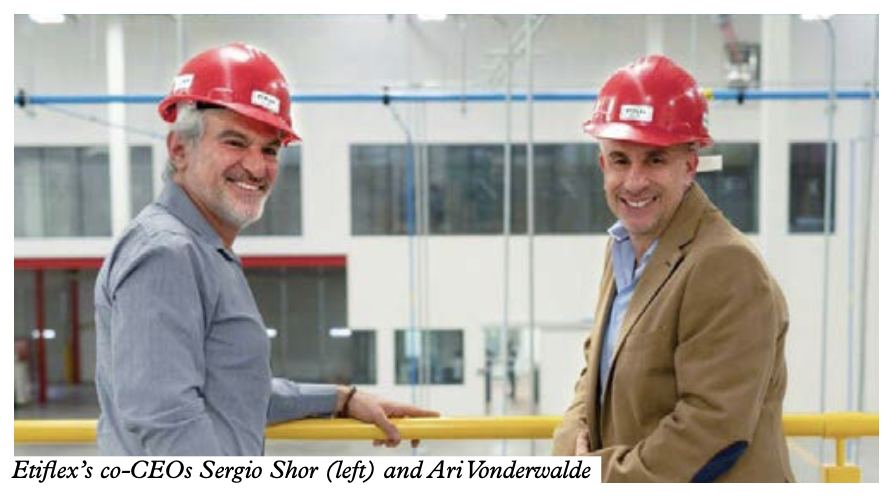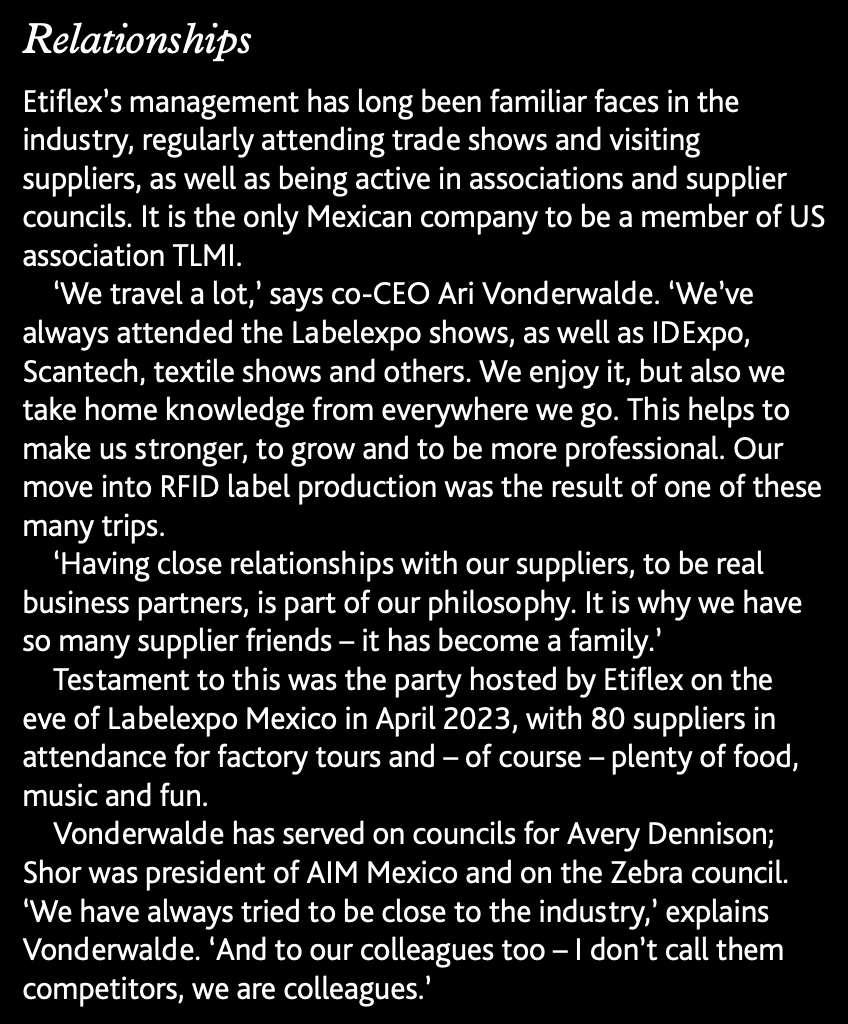The evolution of Etiflex
The Mexican converter, a pioneer in data-led production, is further automating its operations with a new Cerm MIS.

Mexican label converter Etiflex has come a long way since its foundation in 1981. Today considered one of the leading converters in the country and wider region, it is known as a pioneer in data-led production, variable information printing, tickets and RFID labeling. Etiflex serves a broad range of industries, including food and beverage, textile, automotive, personal care, pharmaceutical and cosmetics, as well as producing tickets for events and transport. Production takes place in Mexico City, and the company runs sales offices in Chihuahua, Guadalajara, Monterrey, Querétaro, Tijuana and Toluca.
In 1981 the company’s founders, who had studied together at university, were working in different industries but liked the idea of starting a business together. They met at Loma Linda restaurant in Mexico City to hatch a plan, and shortly afterward founded Etiflex in a factory nearby.

It was just the first of many fateful decisions in the company’s history to be taken in a restaurant. A coin toss in 1992 at Las Mercedes, near Etiflex’s first plant, determined that Ari Vonderwalde would take operations and Sergio Shor sales. (Today they are co-CEOs.) The decision to install a first Nilpeter press in 2000 was finalized at a restaurant, as was the choice of a new, larger production site in 2017 – facilitated by sketches on the tablecloth. ‘Most of our important decisions are made in restaurants,’ admits Vonderwalde. ‘Food has been part of our journey,’ says Shor.
Early business
Etiflex’s early business was printing price-marking labels and other basic products on a Mark Andy 820 flexo press. Importing assembled tools was a challenge, so the founders would break them down and reassemble them back in Mexico. Family members would help them finish labels by hand.
Sergio Shor, then a computer and electronic engineer, joined in 1990 and implemented Etiflex’s first ERP system. After the company’s original founders invited him to buy into the company, he took charge of the barcode label area of the business, at a time when retailers were beginning to mandate the technology.
Ari Vonderwalde, with a background in chemical engineering, joined in 1992, initially selling industrial barcode printers door-to-door and delivering labels in the trunk of his car. Etiflex was running three Mark Andy presses by then, all 3-color machines, yet was still focused on 1-color production. Vonderwalde learned on the job and the company began to increase its multi-color work. It was around this time that the fateful coin toss took place at nearby restaurant Las Mercedes, with Vonderwalde put in charge of operations and Shor taking control of sales.

Growth began to accelerate. Etiflex moved into the larger Dennison de México facility in 1995, following the Dennison de México’s acquisition by Avery, and began printing textile labels. By 1997 it had moved premises again, begun the ISO:9000 certification process and started producing tickets for events and transport, having upgraded its Mark Andy presses to 5-color machines.
The focus remained on variable information applications until the installation of a Nilpeter press – the company’s first from Europe – which brought more colors and a move into prime label production. Etiflex further broadened its portfolio and from that point began installing a new press every year, mainly from Nilpeter and Mark Andy. ‘Our strategy is always to have twin presses, so if a supplier sells us one and we are happy with it, we will buy a second,’ says Vonderwalde.
Etiflex began digital printing in 2010 with an HP Indigo. ‘Before that, it hadn’t made much sense to us,’ recalls Vonderwalde. ‘The early pitch was “Don’t lose money on short runs”. We weren’t printing much short-run work for prime labels. But we studied it and began to see opportunities to move into new markets. Promotional labels, for example, became an important area. Having both flexo and digital printing was complementary – each technology helped bring opportunities to the other. Today, we are one of the top roll-to-roll printers in Mexico in terms of click-rate.’
RFID label printing began shortly afterward. ‘Thanks to our travels and close relationships with associations such as AIM we could see that RFID was closer to barcode technology than to label printing,’ says Vonderwalde. ‘We didn’t want to spend a lot of money on a big RFID label printing line, so we created our own. It’s a flexible system with 10 colors, reverse printing, delam/relam, specific controls, and we can add different stations. We use it to print all our RFID labels.’ Etiflex produces RFID labels for logistics, textile, automotive and industrial applications, among others.

In 2019, Etiflex was on the move again. ‘The area around the factory was becoming more residential,’ says Shor. ‘The people who owned the land wanted to build on it. So we began looking for a new facility, visiting 30 or 40 places because we wanted to make the right choice and we didn’t want to lose any staff. In a restaurant, we sketched notes on the tablecloth and that’s how we chose the new factory.’
The 11,500sqm building was just a shell when Etiflex bought it, so the company created a team to design the layout of the new plant, which remains its headquarters. It took six months to refurbish and a further three months to move equipment. The additional space allowed the installation of two more presses, further increasing capacity.
Less than a year after settling into the new factory, the pandemic hit. ‘Sectors such as entertainment and transport basically shut down,’ recalls Vonderwalde. ‘We had to lay off some staff but fortunately, we were able to hire them back a few months later. The ticket side of the business suffered, but pharma grew, and e-commerce and food boomed.’
One impact of the pandemic, says Shor, was an increase in Etiflex’s exports. ‘We began to export to the US more during this time, and also to Central America. Previously we had exported less than 1 percent of our production – by late 2022 it had risen to 15 percent. Labor shortages in the US were part of the reason, as well as the material shortages, and subsequently the nearshoring trend. We source materials from many parts of the world – Europe, Asia, South America – so we can maintain a consistent supply.’
Data
Etiflex has a long-established culture of using data to measure and improve its productivity. It was an early adopter of the Sispro planning and production control system from Argentina-based UpSoftware and runs Microsoft Dynamics ERP software.
‘We are pioneers in the area of collecting and analyzing data,’ says Vonderwalde. ‘What you can’t measure, you can’t control. Using KPIs and metrics is essential.’
Etiflex’s latest development in this area is the installation in mid-2023 of an MIS from Cerm and software from Esko. ‘The more informed our decisions are, the better,’ says Vonderwalde. ‘The Cerm and Esko software links all the different systems at use within the company.

‘The new system allows us to process orders more quickly, to better understand them from the very beginning, to better understand the cost of the label, and to be more accurate with delivery times. It will also allow us to track a lead to a sale.
‘Usually, we have around 1,500 orders in our pipeline. It is complicated to schedule everything efficiently. The Cerm MIS schedules the jobs in the most efficient order, specifying which machine to use for each job, and knows if it is possible to meet the deadline. It means you can tell customers in advance if there is a delay.’
‘We want to continue to understand our productivity, to analyze, to keep improving our efficiency,’ emphasizes Shor. ‘The only way to be as efficient as possible is to automate the line as much as you can, and to have the best materials.’
With Etiflex so dedicated to data collection and automation, how do the co-CEOs view the potential impact of artificial intelligence? ‘We have been working in business intelligence for a few years,’ says Vonderwalde. ‘I’m not saying that AI is embedded in our DNA – but it is going to happen. Soon it will give us the ability to predict areas of our business, which will be a huge advantage.’
What else does the future hold? ‘One of our goals is to become an industry association-certified laboratory for material testing,’ says Vonderwalde. ‘We want to understand all the standards in the industry, from associations such as TLMI and Finat. Because of the scarcity of some materials during the pandemic, we spent a lot of time testing different constructions and experimenting with different materials. We believe this is important because it increases flexibility. We are always trying to understand the industry and to develop.’
But first... ‘Later we are meeting people from HP Indigo at a restaurant.’

Stay up to date
Subscribe to the free Label News newsletter and receive the latest content every week. We'll never share your email address.


